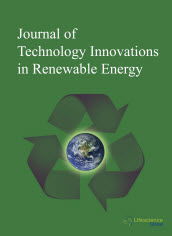jtire
|
|
|
Abstract: Using wind power generation is another alternative for remote homes, where there is no electricity grid. Especially in Ecuador there are several places where the wind resource is really stable for the year, though at times the wind regime it becomes turbulent wind speeds become quite high exceeding 12 m / s affecting the wind turbine components. Generally in the Ecuadorian highlands are available permanent winds of medium intensity capable of generating electricity, but by having a system of turbulence for short periods of time it jeopardizes the deployed equipment and therefore the investments made by what this study guarantees the stability of small wind turbines that are very useful in our environment to generate electricity in field type housing shelters. Keywords: Control, Wind Generators, Protection.Download Full Article |
|
|
|
Abstract: This paper presents a thirty year (1976-2005) assessment of wave energy resource within the South China Sea (SCS) by simulation. Significant wave height (SWH) between simulation and observation shows good agreement. This shows the reliability of an along-side simulated wave period in estimating wave energy in the SCS. Results show that estimates of wave power density are more reliable in the north-central SCS and most sufficient during winter. The annual mean wave power density peaked at 12.7kW/m and 12.9kW/m during years 1986 and 1999 respectively while the highest seasonal mean of 29kW/m occurred in year 1999 during winter. The wave power density is most stable in winter and is generally more stable in offshore regions of SCS. Wave power density is most stable in years 1976, 1997 and 2004 with stability values of 1.96, 1.98 and 1.9 respectively. The stability value of 0.9 in year 1980 is the greatest in the winter of all years. Relative-rich energy regions occupy the largest area during winter. The relatively richest energy is generally concentrated in the central and north-central SCS. No area is identified as a relative-rich energy region during spring. Winter 1999 has the highest relative-rich energy with value of 37kW/m. Keywords: South China Sea, Wave power density, Wave power stability, Relative-rich energy, Distribution.Download Full Article |
|
|
|
Abstract: Spent bleaching clays (SBCs) from vegetable oil refineries are industrial wastes. The clays contain large amount of oils (20-25%), which are good feedstock for biodiesels. Non-thermal in situ trans-methylation and trans-ethylation of oils in the SBC from rice bran oil (RBO), crude palm oil (CPO) and palm kernel oil (PKO) are rapid and can be accomplished in minutes with an alkaline catalyst. Thus, the process may possibly be used for large scale preparation of ethyl biodiesel. Keywords: Biodiesel, ethyl ester, methyl ester, palm kernel oil, palm oil, rice bran oil, spent bleaching clay.Download Full Article |
|
|
|
Abstract: This study reviews and analyses the recent research and development and trends in the applications of wind energy and it also discusses and summarizes the topic. We show the usage and the influence of text mining on the different aspects of wind energy systems especially for hot topics and trends of wind energy area. Text mining provides the state of the art in this area that will be a good guidance for future research work. The main results achieved from the study have shown that the text mining technique are adequate for serving as a proof of concept and as a test-bed for deriving requirements for the development of more generally applicable text mining tools and services within wind energy science. . Keywords: Wind energy research, text mining, concept extraction, clustering.Download Full Article |
|
|
|
Abstract: The present study characterized the physical property, total solids (TS), volatile solids (VS) and Carbon to Nitrogen ratio (C/N ratio) of tannery solid waste (TSW). Five different combinations with or without cow dung (CD) were assessed for their biogas production suitability in triplicate batch digesters (D-1, D-2, D-3, D-4, and D-5) with a total volume of 2.8L. The results showed that TS, VS and C/N ratio of wastes were 56.37%, 76.34% and 29.05%, respectively. The results also suggested that the highest volume of biogas (4,756 ml) with a methane content of 60.37% was produced by the digester containing 75% TSW and 25% CD and the lowest biogas (2,539 ml) with quality of 68.06% was produced by digester containing 100% CD. The average methane contents of different digesters were D-1 (100% TSW) 53.23%, D-2 (75% TSW: 25% CD) 60.37%, D-3 (50% TSW: 50% CD) 58.78%, D-4 (25% TSW: 75% CD) 57.66% and D-5 (100% CD) 67.31%. Total and volatile solid removal efficiency of all digesters was in the range of 42.27-76.34% and 47.16-79.23%. The study concluded that TSW is a good feedstock for biogas production by utilizing agro-industrial based organic solid waste for bioenergy production. Keywords: Waste-to-energy, tannery waste management, solid waste reduction.Download Full Article |


